|
|||||||||
|
 |
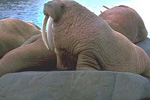 |
The strangest features of some creatures are the very elements which have allowed them to survive. Claymation of prehistoric species shows the ways in which odd shapes evolved into forms we know today. The Musk Ox’s circle dance and the Armadillo’s shell game are explained. Also seen are the one-in-a-million white Moose, and the confused courtship of a prairie Grouse hybrid. |
 |
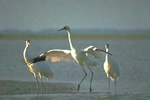 |
This exploration of wildlife’s struggle for survival presents many Endangered Mammals, Birds and Fishes that have never been filmed before. Some are large and impressive — others small and overlooked. Seen are interviews with four prominent biologists, each an expert on a particular Endangered Species. Without our concern, many of these rare animals will never be filmed again. |
 |
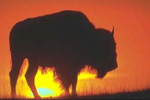 |
With ravaged rocks and grotesque patterns of erosion, South Dakota’s Badlands National Park looks as empty and desolate as the back side of the moon. But interspersed among its spires and castles are rich grasslands and lush gullies which provide for sizeable populations of large grazing and small burrowing animals. Birdlife is abundant and Mammals range from Bison to Badger. |
 |
 |
Even those as bold as the Bobcat know it’s not very bright to pick a fight with a Badger. The quarrelsome Badger remains ready to challenge any opponent, whether to defend itself or to steal a meal. Come meet the pugnacious Badger, and see how its enormous curved claws and array of sharp teeth help it to frighten away potential predators and also to excavate its elaborate den. |
 |
 |
Long the misunderstood subject of myth and legend, Bats are hardly a favorite form of wildlife. Yet they are among our most valuable — and interesting — fellow creatures. This amazing study of America’s only flying mammals reveals, with close-up and slow-motion cinematography, their fascinating habits and abilities, and offers fresh insight into the dark world of cave ecology. |
 |
 |
Yosemite, one of our most spectacular National Parks, is home to six species of Chipmunks. Each is found at a different altitude, from dry foothills to 13,000-foot peaks. The life stories of several of these frisky, appealing creatures, and their relationship to humans, are seen amid the grandeur of Bridal Veil Falls, Half Dome and the world’s oldest and largest Giant Sequoias. |
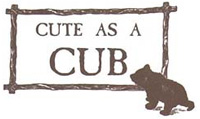 |
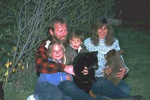 |
Marty Stouffer’s children, Hannah and Luke, narrate a charming romp. Grizzly, Polar, and Black Bear cubs learn how to fish and forage, swim, climb and just have fun. We see Hannah and Luke’s encounter with a pair of Black Bear cubs near their Colorado home. Never-before-filmed scenes of Wolverine cubs top off this delightful and heartwarming tribute to childhood. |
 |
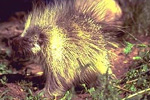 |
Wild creatures have evolved a variety of fascinating means for discouraging predators. Some of these methods of protection, such as the Porcupine’s quills, are built right into the animal’s anatomy. Other devices, like the ability of the Opossum to “play dead”, are behavioral. Survival usually depends on a complex set of interactions between predator and prey. |
 |
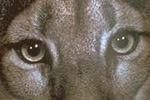 |
Did you ever wonder why a predator’s eyes are right in the front of its head, while its prey’s eyes are on either side? How can an Insect have as many as 30,000 separate eyes? How do a Frog’s eyes help it swallow? Why are some animals color-blind? Come along as we look at how Nature has given each species its own unique way of looking at the world. |
 |
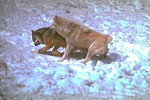 |
Is there a peaceable kingdom? Not really. Wild animals have “sibling rivalries” just like humans. Ironically, related species compete more frequently, and more intensely, than do non-related species. These family conflicts can be fatal when it comes to the crucial concerns of food, territory, or affection... and it’s not always the larger or more powerful “cousin” which wins the competition! |
 |
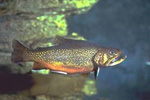 |
A “Fish” is such a standard shape that we seldom think how ancient, yet how perfectly modern, is this superbly successful design. Here we see its most incredible variations, from the largest “living fossils” — huge, prehistoric Alligator Gar — to the smallest — the dazzlingly colorful Darters. This underwater exploration leaves us marvelling at their adaptations. |
 |
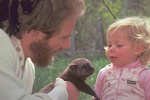 |
The slender, luxuriously-furred Fisher is misnamed — it does not catch fish. Cat-sized members of the Weasel family, Fishers are rare, energetic and playful — but out of place in anyone’s home! This fun-loving story shows how an orphaned pair of these frisky predators were rescued by Marty Stouffer and adopted by his family. They grow up with Marty and Diane’s daughter Hannah. |
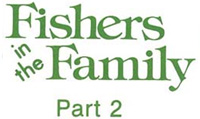 |
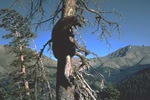 |
The growing Fishers need to learn how to survive on their own before they can be released into the forest. Marty takes them on regular trips into the mountains that will some day be their home — each time they go deeper into the wilderness. But the curious Fishers would rather explore and meet new wild friends — like a Black Bear, Skunk and Mule Deer — than continue their education. |
 |
 |
Family camping trips take on added interest now that Marty and Diane Stouffer’s daughter Hannah is old enough to keep up with them. There’s fun to be had and lessons to be learned as they share with Hannah the secrets of the wild creatures and wild places they love. We see that a child’s enormous capacity to learn from Nature is one of our most precious inborn gifts. |
 |
 |
Whether it’s the gnarled old Scrub Oak that hosts an intricate web of a Spider, or a raging river filled with Trout, a creature’s habitat is as varied as the thousands of species that live here in North America. In this program, we’ll uncover some of the many interesting places Mammals and Birds dwell, and learn why habitat is so important in their fight for survival. |
 |
 |
This poetic look at America’s forests leads us into the shadowed depths of woodlands from Louisiana’s steamy cypress swamps to the moody rain forests of Washington’s Olympic National Park. We marvel at the great variety of forests across our land, meet the wild inhabitants of these timberlands, and see how each wild ecosystem is constantly changing, yet also kept in balance. |
 |
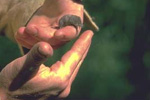 |
Of the more than 4000 species of Mammals on earth, the tiny Shrew has earned a reputation for being the most voracious. It devours almost anything in its path, including creatures much larger than itself. Its heart is hardly malicious, but beats at a rate of 1000 times a minute. This reflects a metabolism which requires the Shrew to consume several times its body weight daily. |
 |
 |
In Spring, the wilderness is full of new baby animals. Unfortunately, some will lose track of their parents when exploring their new surroundings. Enter the Stouffer family to nurse these youngsters until their return to the wild. Pure silly fun is enjoyed by all in raising a Mountain Goat, Black Bears and Kestrel Falcons. The magic of children and discovery unite in this playful adventure. |
 |
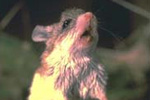 |
Through the night, a ravenous predator stalks its unwary prey. With a swift bite to the skull, it slays the victim, then throws back its head and howls. But this beast that hunts like a Weasel and howls like a Wolf is neither — it’s the five-inch Grasshopper Mouse of our western deserts and plains. It feasts on Tarantulas, Scorpions, and even other Rodents — yet displays close family ties. |
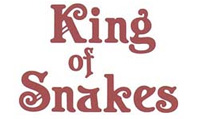 |
 |
In a confrontation with a Rattlesnake, this snake will win. Unharmed because it is immune to the venom, it swallows its victim whole. This amazing serpent is the Kingsnake. Reigning monarch among Reptiles, it is a world-class beauty, with a medley of patterns and colors. We see combat, mating, egg-hatching and feeding behavior in several kinds of Kingsnakes. |
 |
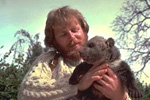 |
Marty Stouffer is studying wildlife in a remote Colorado wilderness. One spring day, he comes across the tracks of a Grizzly Bear — thought to be extinct in the state — and he follows and meets face-to-face with a magnificent male Grizzly. Excited by his discovery, Marty adopts a female Grizzly cub from a zoo. He and Griz share a cabin as Marty teaches her how to survive. |
 |
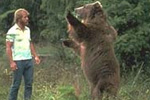 |
Over the summer, the adventurous cub encounters many other creatures, among them a hungry Cougar. As winter approaches, Marty digs a den for Griz, and while she sleeps, he goes off to observe wildlife which does not hibernate. In April, Griz emerges from her den, and must learn one last lesson — to fear humans, even Marty. This separates man and bear forever. |
 |
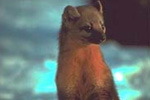 |
From branch to branch leaps a lithe hunter, alert in its pursuit of Squirrels, Birds and other prey. Its rich golden fur blends with the trunks of the Spruce trees in our northern forests; its bright eyes shine as it hunts and forages at night. We follow a young Marten from early spring into winter and see how this most solitary member of the Weasel family earns — leap by leap — the right to survive. |
 |
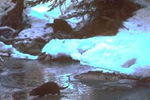 |
It’s most widely known as a status symbol when its skin is fashioned into luxury garments. But there’s much more to a Mink than a fur coat. It’s a fascinating member of the Weasel Family — as graceful in water as an Otter, as feisty on land as a Wolverine, and as pungent under stress as a Skunk. We follow a mother Mink as she hunts, mates and rears a family near lovely Lake Superior. |
 |
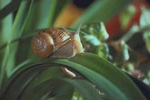 |
Mollusks are among the oldest living organisms, their fossils dating back 600 million years. And to this day, wherever there’s water — fresh or salty — you’ll find at least one of these fascinating Invertebrates. The second largest group in the Animal Kingdom, they come in a wide variety of sizes, shapes, and surroundings, from high-mountain Snail to deep-ocean Squid. |
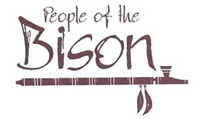 |
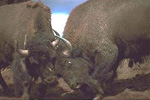 |
Bison once grazed America in herds so vast the prairie appeared a moving blanket of deep brown. The native people of the Great Plains molded their culture around the shaggy beast they called “Tatonka.” When westward moving Europeans slaughtered the species, they broke a sacred union of people and provider. Yet, Bison are now returning, even to ancient Indian lands. |
 |
 |
How did a young wildlife-lover get started making motion pictures of his favorite subject? How does Marty Stouffer film the amazing, yet difficult — and often dangerous — scenes for WILD AMERICA? Viewers are invited to learn the secrets of wildlife cinematography — to share the frustration of failure and the exhilaration of success — as the behind-the-scenes story is revealed. |
 |
 |
Closely related to the Giant Panda, with a dexterity almost human, the Raccoon, Ringtail and Coatimundi each combine in a special way the features of several other animals. Using their bushy tails for balance, and their paws as clever tools, they are Fox-like, Cat-like and Monkey-like all at once. Each is different, yet each is very intelligent and amusingly adapted. |
|
|
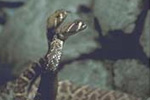 |
While investigating life in an Oklahoma cave, Marty Stouffer discovers a pair of male Western Diamondback Rattlesnakes engaged in an extraordinary “combat dance”. Sinuous bodies swaying upright, the intertwined serpents clench and strain as they try to wrestle each other to the ground. All stages of this hypnotizing Reptilian phenomenon are seen for the first time. |
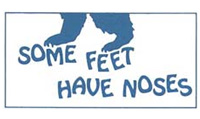 |
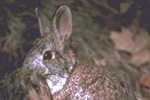 |
Did you know that feet do much more than just move animals from place to place? They are fascinating in their wide diversity. Some feet can smell and some can even taste; a few feet are as dexterous as the most skillful hands and others move their owners at speeds of up to 70 miles per hour! We focus on Nature’s fantastic feat in creating such an amazing array of fascinating feet. |
 |
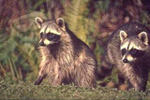 |
Haunting beauty and mystery characterize our southern swamps. They teem with an amazing — and amusing — variety of creatures. Where land meets water is the richest nursery of life. Alligators lurk as they have since prehistoric times, an Anhinga swims underwater and spears its meal. In the heart of the swamp, an astounding fish changes its color and pattern in seconds. |
 |
 |
Last but surely not least, tails are a vital and intriguing part of any creature’s anatomy. Animal’s tails come in a fascinating variety of shapes and sizes. Used as hands, rudders and shovels, their form and function are as varied as the creatures to which they are linked. This exciting tale takes us behind the beast as we examine one hundred and one different kinds of tails. |
 |
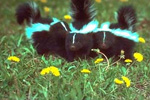 |
There are four American species — Striped, Spotted, Hog-nosed and Hooded — and each is a variation on the same theme: black and white, easily provoked and wickedly perfumed! Understandably, Skunks have few enemies other than cars, household pets and large Owls. But they do have many interesting traits which are often overshadowed by an emphasis on the obvious. |
 |
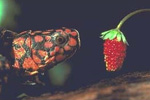 |
They were here even before the Dinosaurs appeared, and they remain with us today — tough and adaptable, patient and persistent. Their unique design includes an armored shelter that enables the Turtle to prosper in deserts, forests, swamps, rivers, and seas. This program highlights the casual lifestyles of several noteworthy North American species of Turtles. |
 |
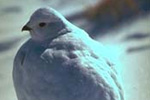 |
On the Arctic tundra, predator and prey alike are aided by fur or feathers the color of snow. Some, like the Gyrfalcon and Snowy Owl, stay white year round; others, like Ptarmigan and Snowshoe Hare, turn white for winter. Forcing its inhabitants to migrate, adapt, or perish, the world’s harshest, yet most sensitive, environment is the setting for a continual life-and-death drama. |
 |
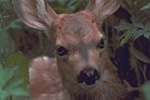 |
Childhood is the age of delight and discovery for wild animals. Lively baby Skunks, Flying Squirrels, Owls, Black Bears, Raccoons and other wild youngsters learn life-saving skills — and have fun — growing up in the wilderness. A nocturnal sequence shows the complete life cycle of a Toad, from embryo to “toadlet.” Also seen is the playful springtime cavorting of Mountain Goat kids. |
 |
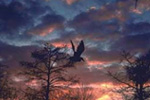 |
From the first — and smallest — Refuge, created on Florida’s 3-acre Pelican Island in 1902, to the 8,900,000 acres of Alaska’s Arctic National Wildlife Refuge, our Refuge system is unmatched by any in the world. In areas from Maine to Arizona, millions of pristine acres have been set aside for native wildlife. We explore these Refuges, as well as many of the creatures that inhabit them. |
 |
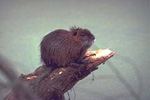 |
Come along and trace the misadventures of America’s wildlife aliens. Throngs of European Starlings, hordes of Norway Rats, scores of South American Nutria and millions of Middle Eastern Mussels displace native species and weaken Nature’s well-woven fabric. Not all are unwelcome. Hunters prize Chinese Pheasants and birders feed flocks of Monk Parakeets. |
 |
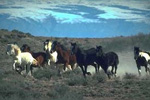 |
Five hundred years ago, Spanish Conquistadors re-introduced the Horse to the Americas. A handful escaped and grew into vast herds by the 1800’s. These “Mestanos” or Mustangs, inspired Native Americans to develop an elaborate horse culture on their “Sacred Dogs.” Raven, a Mustang stallion, leads his band through the Arrowhead Mountains in this true story of survival. |
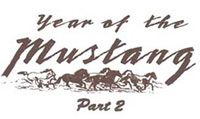 |
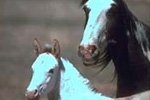 |
As our fascinating story of a band of Wild Mustangs continues, Raven, the Mustang stallion, and his son Diamond are released with what is left of their decimated band. They battle mare-stealing “bachelor” stallions, and witness the birth of the extraordinary colt named Cloud. We travel along with this courageous band as their incredible adventures unfold. |